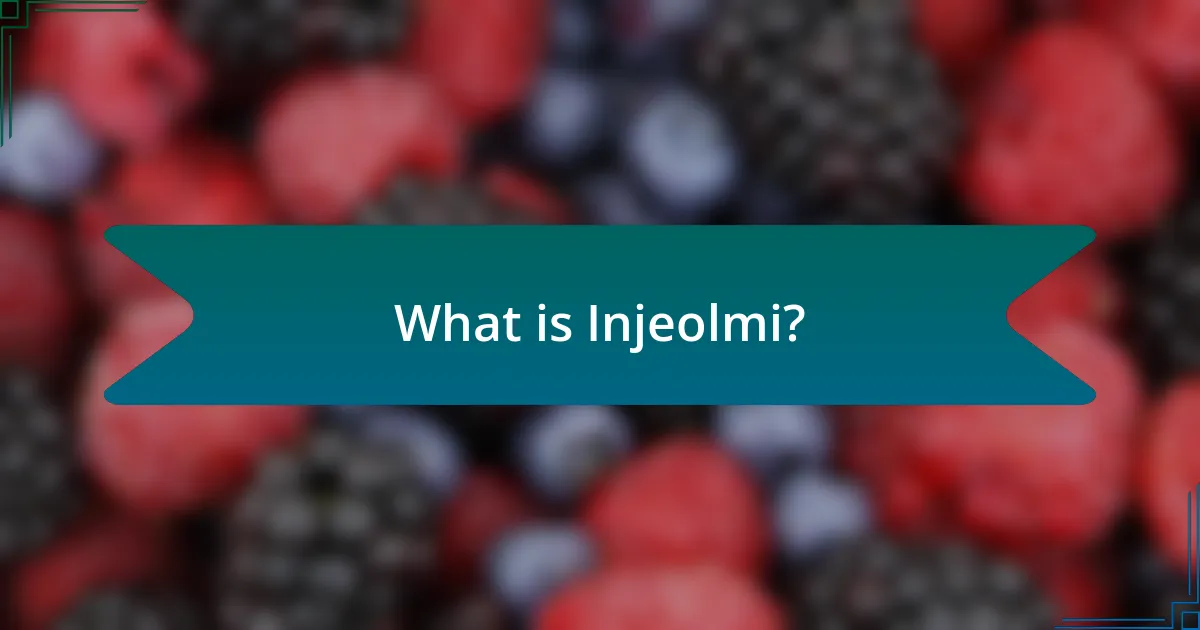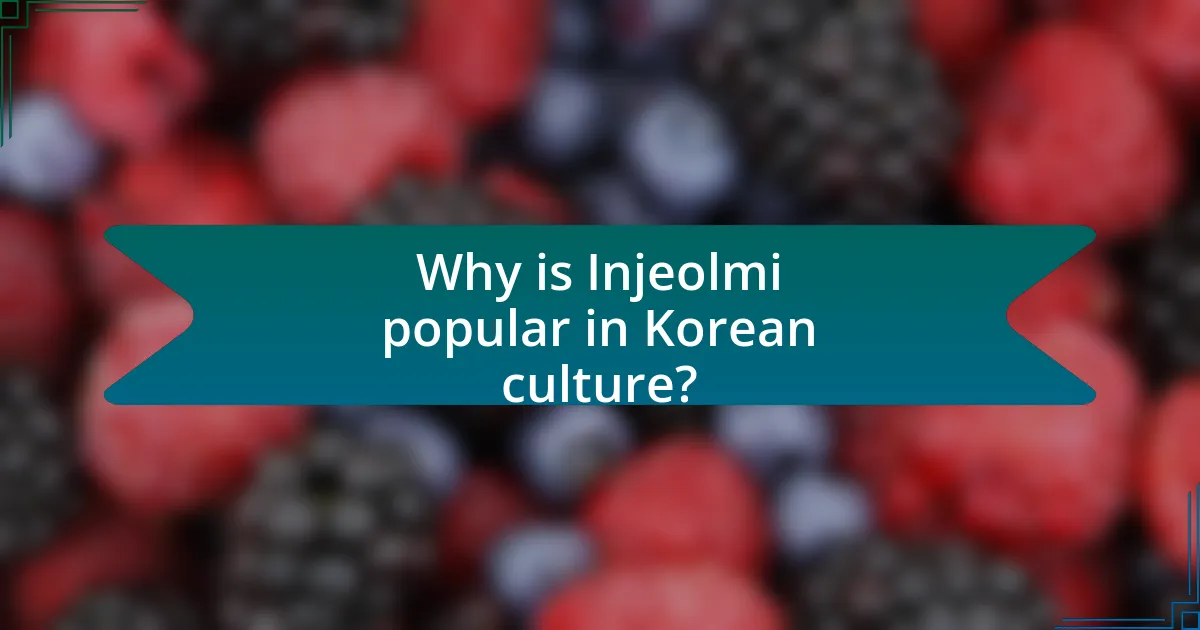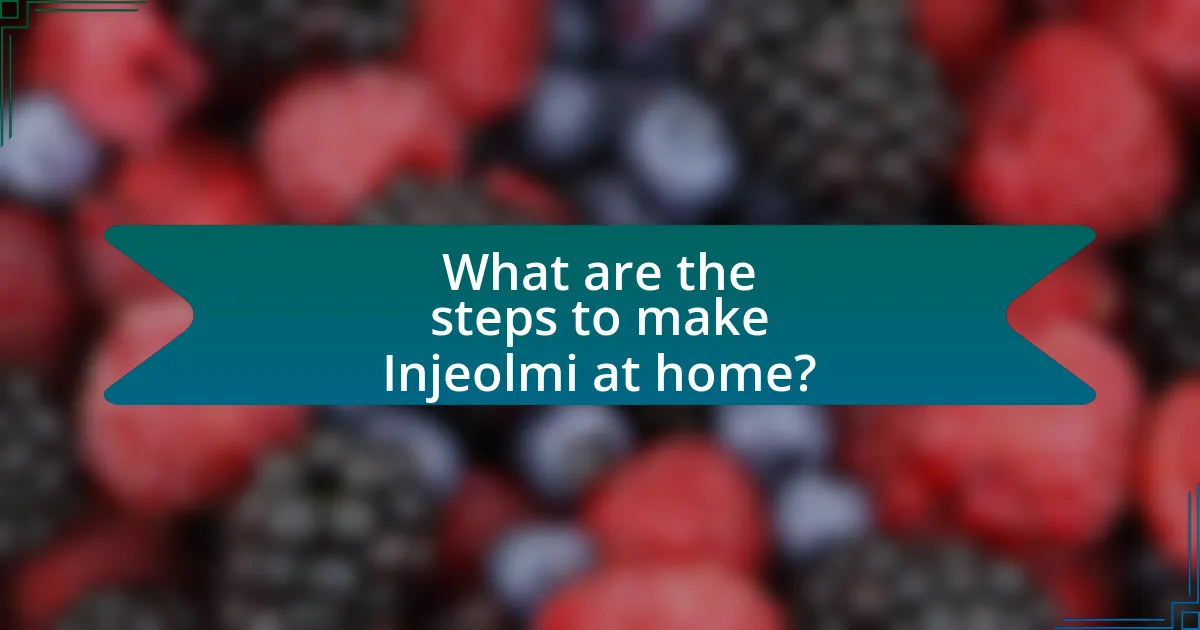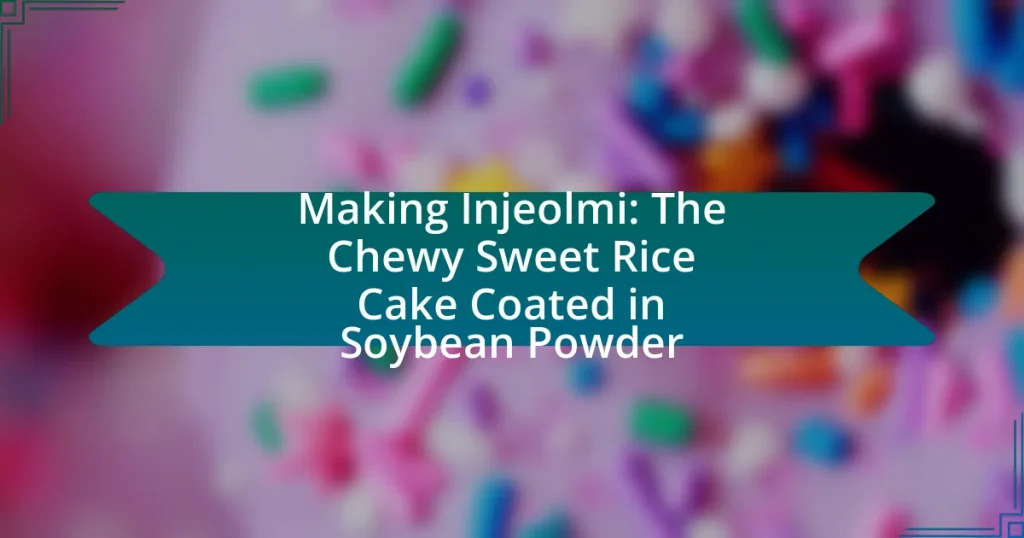Injeolmi is a traditional Korean rice cake made from glutinous rice flour, known for its chewy texture and coating of powdered soybean flour. The article details the traditional preparation methods, essential ingredients, and the cultural significance of Injeolmi in Korean celebrations and hospitality. It also explores modern variations and contemporary reinterpretations by chefs, providing insights into the evolution of this beloved dessert. Additionally, practical tips for making Injeolmi at home, troubleshooting common issues, and best storage practices are included, ensuring a comprehensive understanding of this iconic Korean delicacy.

What is Injeolmi?
Injeolmi is a traditional Korean rice cake made from glutinous rice flour, which is steamed and pounded to achieve a chewy texture. This rice cake is typically coated in powdered soybean flour, giving it a distinct flavor and appearance. Injeolmi has historical significance in Korean culture, often served during celebrations and special occasions, highlighting its importance in traditional Korean cuisine.
How is Injeolmi traditionally made?
Injeolmi is traditionally made by steaming glutinous rice flour to create a chewy rice cake. The process begins with soaking glutinous rice overnight, followed by grinding it into a fine flour. This flour is then mixed with water to form a dough, which is steamed until it becomes firm and elastic. After steaming, the rice cake is cooled and cut into pieces, which are then coated in finely ground soybean powder, giving Injeolmi its distinctive flavor and texture. This method has been practiced in Korea for centuries, highlighting its cultural significance and traditional preparation techniques.
What ingredients are essential for making Injeolmi?
The essential ingredients for making Injeolmi are glutinous rice flour, water, and soybean powder. Glutinous rice flour is the primary component that gives Injeolmi its chewy texture, while water is necessary to create the dough. Soybean powder, often sweetened, is used to coat the rice cake, adding flavor and a distinct finish. These ingredients are fundamental to the traditional preparation of Injeolmi, which is a popular Korean dessert.
What is the significance of the cooking method in Injeolmi preparation?
The cooking method in Injeolmi preparation is significant because it directly influences the texture and chewiness of the final product. The traditional steaming of glutinous rice, followed by pounding, creates a sticky and elastic dough essential for achieving the characteristic chewy consistency of Injeolmi. This method ensures that the rice starch gelatinizes properly, which is crucial for the desired mouthfeel. Additionally, the technique of pounding the rice enhances the dough’s cohesiveness, allowing it to hold the soybean powder coating effectively, thus impacting both flavor and presentation.
What are the characteristics of Injeolmi?
Injeolmi is a traditional Korean rice cake characterized by its chewy texture and coating of finely ground soybean powder. This rice cake is made from glutinous rice, which is steamed and pounded to achieve its distinctive elasticity. The soybean powder not only adds a nutty flavor but also enhances the cake’s visual appeal with its light brown color. Injeolmi is often enjoyed as a snack or dessert and is known for its subtle sweetness, making it a popular choice during celebrations and special occasions in Korean culture.
How does the texture of Injeolmi contribute to its appeal?
The texture of Injeolmi significantly enhances its appeal by providing a unique chewy consistency that is both satisfying and enjoyable to eat. This chewy texture is achieved through the use of glutinous rice, which, when steamed and pounded, creates a sticky and elastic quality. The contrast between the soft, chewy rice cake and the fine, powdery soybean coating adds an additional layer of sensory experience, making it more pleasurable. The combination of these textures not only makes Injeolmi distinctive among rice cakes but also contributes to its popularity in Korean cuisine, as it engages multiple senses during consumption.
What flavors are typically associated with Injeolmi?
Injeolmi is typically associated with nutty and sweet flavors. The nutty flavor primarily comes from the soybean powder that coats the rice cake, which is made from roasted and ground soybeans. This coating not only adds a distinct nuttiness but also enhances the overall sweetness of the rice cake, which is made from glutinous rice and often has a subtle sweetness from added sugar or honey. The combination of these flavors creates a unique taste profile that is both rich and satisfying.

Why is Injeolmi popular in Korean culture?
Injeolmi is popular in Korean culture primarily due to its unique texture and flavor, which are derived from glutinous rice and soybean powder. This traditional rice cake is often associated with celebrations and special occasions, such as weddings and holidays, reinforcing its cultural significance. Additionally, Injeolmi’s chewy consistency and nutty taste make it a favored snack among Koreans, contributing to its widespread enjoyment. The dish’s historical roots can be traced back to the Goryeo Dynasty, where it was served as a royal delicacy, further solidifying its status in Korean culinary heritage.
What occasions are Injeolmi commonly served at?
Injeolmi is commonly served at celebrations such as birthdays, weddings, and traditional holidays like Chuseok and Seollal. These occasions highlight the cultural significance of Injeolmi in Korean cuisine, where it is often enjoyed as a symbol of good fortune and prosperity. The rice cake’s chewy texture and sweet flavor make it a favored treat during these festive gatherings, reinforcing its role in Korean culinary traditions.
How does Injeolmi fit into traditional Korean celebrations?
Injeolmi is a traditional Korean rice cake that plays a significant role in various celebrations, particularly during holidays like Chuseok and Seollal. This chewy sweet rice cake, coated in soybean powder, symbolizes prosperity and good fortune, making it a popular offering during these festive occasions. Historically, families prepare Injeolmi to honor ancestors and share with loved ones, reinforcing social bonds and cultural heritage. Its presence at celebrations highlights the importance of food in Korean traditions, where specific dishes are associated with particular events, thus embedding Injeolmi deeply into the fabric of Korean cultural practices.
What role does Injeolmi play in Korean hospitality?
Injeolmi serves as a significant symbol of hospitality in Korean culture, often offered to guests during special occasions and celebrations. This chewy sweet rice cake, coated in soybean powder, embodies warmth and generosity, reflecting the host’s respect and care for their visitors. Traditionally, Injeolmi is prepared for important events such as weddings, birthdays, and holidays, reinforcing its role as a cherished treat that enhances social bonds and communal experiences. The act of serving Injeolmi not only showcases culinary skill but also signifies the host’s desire to create a welcoming atmosphere, making it an integral part of Korean hospitality practices.
How has Injeolmi evolved over time?
Injeolmi has evolved from a traditional Korean rice cake primarily made from glutinous rice and coated with soybean powder to a more diverse dessert that incorporates various flavors and ingredients. Historically, Injeolmi was enjoyed during celebrations and special occasions, reflecting its cultural significance. Over time, modern variations have emerged, including the addition of fillings such as red bean paste, nuts, and even fruit, catering to contemporary tastes. This evolution highlights the adaptability of Injeolmi, allowing it to maintain its relevance in both traditional and modern culinary contexts.
What modern variations of Injeolmi exist today?
Modern variations of Injeolmi include flavors such as matcha, black sesame, and chocolate, which enhance the traditional chewy rice cake’s appeal. These adaptations often incorporate different coatings or fillings, such as fruit purees or nuts, to cater to contemporary tastes. The introduction of these flavors reflects a trend in Korean cuisine to innovate while preserving cultural heritage, as seen in various dessert cafes and restaurants across South Korea.
How do contemporary chefs reinterpret Injeolmi?
Contemporary chefs reinterpret Injeolmi by incorporating innovative flavors and textures, often blending traditional ingredients with modern culinary techniques. For example, some chefs experiment with fillings such as fruit purees or chocolate, while others may infuse the rice cake with matcha or other contemporary flavors. This approach not only preserves the essence of Injeolmi but also appeals to a broader audience by enhancing its versatility and presentation. Chefs also utilize techniques like sous-vide cooking to achieve a unique texture, demonstrating a fusion of traditional Korean cuisine with global culinary trends.

What are the steps to make Injeolmi at home?
To make Injeolmi at home, follow these steps: First, soak glutinous rice in water for at least 6 hours, then drain and blend it with a little water to form a smooth batter. Next, steam the batter for about 20-30 minutes until it becomes sticky and translucent. After steaming, knead the dough while it’s still warm, then shape it into small pieces. Finally, coat the pieces in finely ground soybean powder to finish the Injeolmi. This method is traditional and ensures the chewy texture characteristic of Injeolmi.
What equipment is needed for making Injeolmi?
To make Injeolmi, the essential equipment needed includes a steamer, a mixing bowl, a wooden spatula, and a flat surface for shaping. The steamer is crucial for cooking the glutinous rice, while the mixing bowl is used to combine the rice flour and water. A wooden spatula helps in mixing and folding the dough, and a flat surface is necessary for shaping the rice cake after it has been steamed. These tools are fundamental in the traditional preparation of Injeolmi, ensuring the texture and consistency required for this chewy rice cake.
How do you prepare the sweet rice for Injeolmi?
To prepare the sweet rice for Injeolmi, first, soak glutinous rice in water for at least 6 hours or overnight. After soaking, drain the rice and steam it for about 30 to 40 minutes until it becomes tender and sticky. This method ensures the rice achieves the desired chewy texture essential for Injeolmi. The use of glutinous rice is crucial, as it contains higher starch content, which contributes to the cake’s characteristic chewiness.
What techniques are used to achieve the perfect chewiness?
To achieve the perfect chewiness in Injeolmi, the techniques primarily involve using glutinous rice flour and proper steaming methods. Glutinous rice flour, also known as sweet rice flour, contains a higher starch content, which contributes to the chewy texture when cooked. Steaming the dough at the right temperature and for the appropriate duration ensures that the starch gelatinizes properly, resulting in a desirable chewy consistency. Additionally, kneading the dough after steaming helps to develop the gluten structure, enhancing the chewiness further. These methods are essential for creating the characteristic texture of Injeolmi, as evidenced by traditional recipes that emphasize the importance of both the flour type and cooking technique.
What tips can help ensure successful Injeolmi making?
To ensure successful Injeolmi making, use glutinous rice flour and steam it properly to achieve the desired chewy texture. Steaming the flour for about 20-30 minutes allows it to hydrate and develop the right consistency. Additionally, kneading the dough while it is still warm helps to enhance its elasticity. Coating the finished rice cake in finely ground soybean powder prevents sticking and adds flavor. Following these steps will result in a well-textured and flavorful Injeolmi, as the proper preparation of ingredients and techniques is crucial for achieving the traditional characteristics of this Korean delicacy.
How can you troubleshoot common issues when making Injeolmi?
To troubleshoot common issues when making Injeolmi, first ensure that the glutinous rice flour is properly steamed; undercooking can lead to a gummy texture. If the Injeolmi is too sticky, increase the amount of soybean powder used for coating, as this helps absorb excess moisture. If the rice cake is too dry, adjust the water content during the steaming process, as insufficient moisture can result in a crumbly texture. Additionally, if the Injeolmi does not hold its shape, check that it has been adequately kneaded, as proper kneading develops the gluten structure necessary for maintaining form. These troubleshooting steps are based on traditional methods and practices in making Injeolmi, which emphasize the importance of texture and moisture balance in achieving the desired outcome.
What are the best practices for storing Injeolmi after making it?
The best practices for storing Injeolmi after making it include keeping it in an airtight container at room temperature for up to two days or refrigerating it for longer preservation. Storing Injeolmi in an airtight container prevents it from drying out and maintains its chewy texture. If refrigerated, it can last for about a week, but it is advisable to consume it sooner for optimal taste and texture. Additionally, to prevent the pieces from sticking together, dusting them lightly with soybean powder before storage is recommended.


